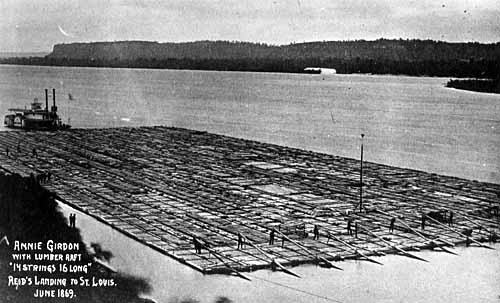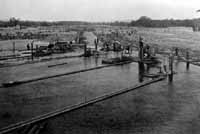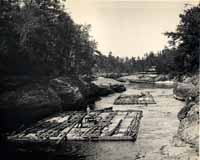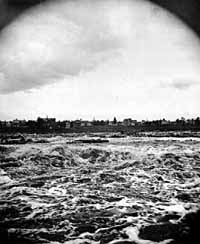

 |
 |
 |
|
 |
In the spring the hewed timber was put into the water and made up into long, narrow sections called "strings." These strings were sixteen feet wide and from eighty to one hundred feet long. Large logs called "floats" were used for the outside. These floats were hewed on the inside and bottom only. Holes were bored entirely through these float logs about every ten feet apart, and strong oak or ironwood pins driven through from the underside with counter sunk heads. These pins stood up a foot or more above the top of the "float logs," and cross binding poles bored at both ends were dropped over the pins and wedged down firmly in place. The body of the string between the float logs was filled in with hewed timber, with the different lengths so placed that the ends would not come in the same line across the string, but would break joints. No holes were bored through these hewed timbers, but on each side of every cross binding pole holes about three inches deep were bored, on a slant away from the pole. Thin strips of tough, blue oak were bent over the binding pole, with one end in each of the holes mentioned. These strips were called "lug-downs." Plugs were driven into the holes to secure the lug-downs in place. These oak strips were almost as tough as leather and kept the timbers from slipping out of place, and also allowed the long string to bend in going over falls and rapids. To make the lug-down strips a straight-grained piece of blue oak was selected and sized to about one and a half inches square. The end of the square stick was then split in for a few inches. A hole was bored through a tree and the split end of the stick run into it. By bending the stick the splits would extend until it would be separated its full length into thin strips. After the timber reached market the lug-downs and plugs were cut off even with the face of the timber and for most purposes did not injure its sale. After the ice had gone out of the river in the spring the strings of hewed timber were started down. The shaved shingles were piled up in the middle, with timbers along the sides, inside of the float pins, to keep the shingles from being washed off in rough water. Oars similar to those used later on sawed lumber rafts were used, one at each end of the string. After the strings had passed the falls and rapids of the upper river and reached a point where the width of the river channel would allow it, two or more strings were joined together into a single raft. Although there were other falls and rapids in the river, the most dangerous place was at Chippewa Falls. The present dam had not been built. The "falls" consisted of a series of rapids and eddies, the present dam being about in the middle of the original falls. Although the water was very rough, it was a common thing for experienced boatmen to run these rapids. I have myself run them, with my first wife and twelve bushels of cranberries in a birch-bark canoe. The worst place in the falls was about half-way down, where a large rock jutted out into the current. This was later known as the "Burned Rock." Adin Randall had tried to crack and remove it by building fires on it. He did not help it much, but later a part of the rock was blasted away. |
 |
|
 below the Falls |
|